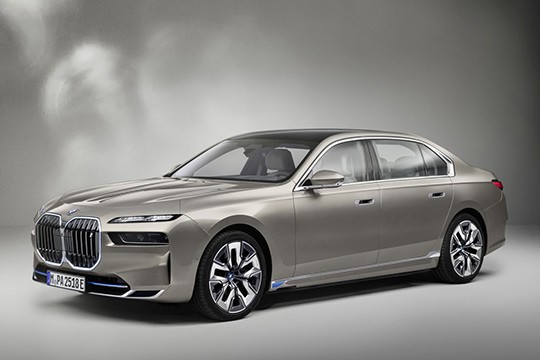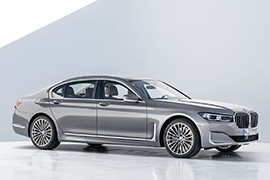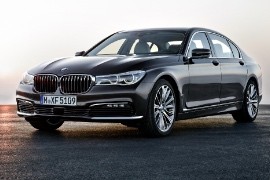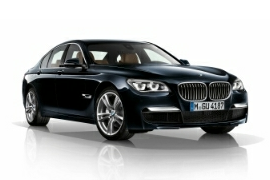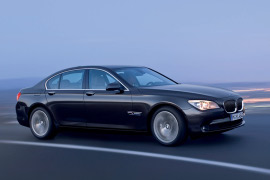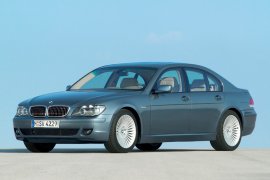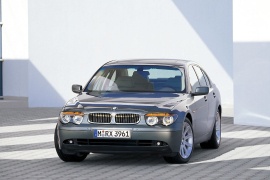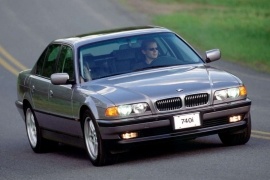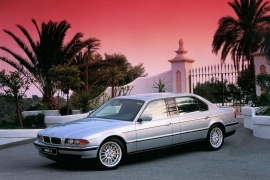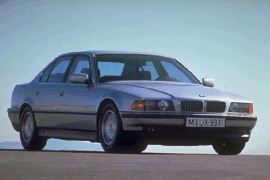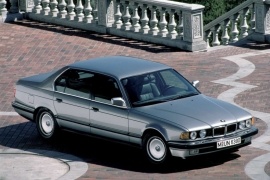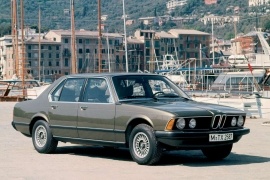BMW 7 Series Models/Series Timeline, Specifications & Photos
First production year: 1977
Engines: Mild hybrid, Mild hybrid diesel, Electric, Diesel, Hybrid, Gasoline, Hybrid gasoline
BMW introduced the seventh generation of its flagship model, the 7 Series, shocking the world with its new design but pleasing everyone with the new technologies offered.
After almost half of century since the launch of the 7 Series' first generation, the German carmaker introduced the seventh sequel of this lineup. It came with lots of innovations and, for the first time, a fully electric version aimed against the EQS from its traditional competitor, Mercedes-Benz.
When BMW launched the 2001 model-year 7 Series, it rocked the world with its disruptive design. Most people didn't like it, but it was the best-selling 7 Series until then. Two decades later, the 2022 model year tried to walk into its ancestors' shoes and featured an intriguing design. Its front fascia sported the tallest and widest grille ever mounted on the German brand flagship model. Moreover, the LED daytime running lights were installed very high and looked like eyebrows above the LED headlights buried deep into the upper side of the bumper, flanking the massive grille. Lower, on the apron, the carmaker added another set of grilles and air-intakes. Another shocking detail was the reinterpreted design element, known as the Hofmeister kink, which sported an angular shape at the bottom of the C-pillar.
Inside, the car featured a 12.3" display behind the steering wheel and, in addition, another 14.9" touchscreen for the infotainment system. Both of them were covered under a common glass, giving the impression of a very long, continuous display. The 2022 7 Series also featured a standard Panoramic Sky Lounge LED roof, which consisted of a single, fixed glass surface surrounded by a steel frame, covered by an electrically operated interior sliding shade. The comfort and luxury level of this new Bavarian flagship was enhanced with a plethora of options, including a 31.3" 8K touchscreen display fitted with Amazon Fire TV.
Under the hood, right from the start, the 2022 7 Series offered a choice of three engines. The base version featured a new, Miller-cycle, twin-turbo inline-six aided by a 48-volt mild-hybrid system. Next in line was the 760i version with a 4.4-liter twin-turbo V8, while the most important addition was the i7 xDrive60, the first full-electric 7 Series in history.
The big 7-series from BMW has received a mid-life cycle refresh in 2019, and it featured numerous upgrades, from the hood to the bottom, inside and outside the car.
Most of the vehicle's parts were either changed or upgraded. A new hood, new front fenders, new headlights, and new grille were offered for the 2019 BMW 7 Series LCI (Life Cycle
Impulse). The air breathers on the front fenders were designed to extract the air from the wheel-well, in order to reduce the aerodynamic lift of the car. In the rear, there was a full-width light strip, with a LED-strip.
Inside, the luxury was obvious and the two options for wheelbases could add more legroom for the rear passengers. For the facelifted model, full Nappa leather and BMW Individual Merino full leather with extended quilting were available.
The engine and transmission range was revised. For the hybrid version, a new xDrive system was available as an option. And, for the 8-speed automatic transmission, a launch-control mode was installed. For those who live their lives one-quarter mile at a time, the 6.0-liter V12 was still available, and with all-wheel-drive. One of the biggest changes in the engine bay was the 4.4-liter V8 unit. It had a pair of twin-scroll turbochargers installed between the two cylinder banks for faster response. It also gained 80 more hp compared to the engine it replaces and had a maximum output of 530 hp. In the 750i xDrive, the two-ton limousine cand sprint from 0 to 100 kph (0-62 mph) in 4 seconds flat.
In top-of-the-class, BMW 7 series returned with a new attitude into a new generation in 2015 as a 2016 model year. It is the first 7 series to be built on the CLAR platform, which means it sits onto a carbon-fiber-reinforced polymer chassis, as seen on the i series (ex: i8).
Almost everything except for the greenhouse on the new 7 Series is brand new, including redesigned bumpers, side air vents, laser headlights now connected to a bigger kidney grille, taillights, exhaust tips, rims, and paint colors.
The same story goes for the interior too, with the model receiving redesigned seats, dashboard, and extra features, especially for the rear occupants. If the previous versions of 7 series interiors were conservative, the new 2016 model is equipped with the latest technology.
Features include a standard LED "light carpet" illuminating your entry as you approach the car. On the inside, you're welcomed by ambient LED lighting and the version of iDrive 5, which notably adds touchscreen functionality and the Gesture Control system.
The 7 Series' standard offers a lot of rear legroom and it is complemented by rear-seat luxuries, including the optional and very cool tablet-based infotainment system that will make you feel like you are traveling in a spaceship.
Luxury doesn't stop here, the wood-trimmed seatbelts, multi-contour seats, and stylish heated armrests all combined with the HQ Bowers&Wilkins Diamond Surround System while admiring the Count in a night-sky-replicating panoramic roof with 15.000 LEDs. What an amazing cabin to be in.
Under the hood are new engines with added power, better efficiency, and a revised 8-speed automatic transmission. CFRP is used along with aluminum for weight reduction, and all models now get a 2-axle self-leveling air suspension.
The 7 series is available with either a rear-wheel-drive or an all-wheel-drive xDrive system. The available engines are either inline-6 cylinders or V8s, diesel, gasoline, or a plug-in hybrid for the BMW 740e with four cylinders and an electric motor with a total output power of 326 hp. A 12-cylinder M760i completed the lineup later.
BMW also keeps the standard high when it comes about safety, offering almost every safety feature known to man. Standard safety equipment includes knee airbags, rear-seat side airbags, and front-seat active head restraints. BMW fits a standard rearview camera and standard parking sensors so that the drivers will not have problems parking a car of such a size.
Attention Assist monitors the driver for nodding heads and displays a coffee cup if it detects an unsafe level of fatigue. The New adaptive headlamps are also standard, taking into account speed and steering angle.
The ultimate Driver Assistance Plus Package adds surround-view cameras and a forward collision warning system with automatic emergency braking. The surround-view cameras also show a Panorama View showing side traffic in front and behind the vehicle.
If you think this is safe enough, the BMW- pushes it forward with The Driver Assistance Plus Package II, with adaptive cruise control and active lane-keep assist, Side Collision Avoidance, and Traffic Jam Assistant.
The adaptive cruise control and Traffic Jam Assistant allow semi-autonomous driving, which means that it will follow cars ahead and provide steering assistance to keep the car in its lane.
Having said all this, the G11/G12 series impersonates with its efficiency, style, safety, and very good performance, BMW justifying its price in the luxury cars category.
BMW 7 Series (G11/G12) 730d 8AT (265 HP)
BMW 7 Series (G11/G12) 730d xDrive 8AT (265 HP)
BMW 7 Series (G11/G12) 730Ld 8AT (265 HP)
BMW 7 Series (G11/G12) 730Ld xDrive 8AT (265 HP)
BMW 7 Series (G11/G12) 740d xDrive 8AT (320 HP)
BMW 7 Series (G11/G12) 740Ld xDrive 8AT (320 HP)
The 7 series from BMW was on the market since 1977 and after many generations, it didn't change its basic idea: a luxury car for the driver.
When the fifth generation of the 7 Series was launched in 2008 it was the big step away from the generation designed in the Chris Bangle era. The new look and the technical updates already transformed the car into a luxurious, fast, limousine that was nice to drive and comfortable on the back-seats.
In 2012, a mid-life cycle refresh was needed. The pollution norms were changed and new technologies should have been included in the BMW flagship vehicle. The exterior changes were not so important. There was a new pair of LED headlights on the front, with a redesigned bumper. The radiator grille had fewer slats on it. In the rear, the LED taillights were connected via a chromed strip.
Inside there were some significant changes in the front as well. For the 2012 7-Series, there was an option for an instrument cluster with a 10.25" black screen that replaced the analog gauges and dials. That brought some changes for the interior lighting that allowed different themes on the dashboard, related to the driving mode chosen by the driver.
For the back-seats, depending on the trim level and the options, the rear passenger was able to change the music or set-up the navigation system via an iDrive rotary-knob located in the center armrest. The new 750 d xDrive and the BMW 730d were equipped to comply with the Euro 6 emission limits.
BMW 7 Series (F01/02) Facelift 730d 8AT RWD (258 HP)
BMW 7 Series (F01/02) Facelift 730d xDrive 8AT AWD (258 HP)
BMW 7 Series (F01/02) Facelift 730Ld 8AT RWD (258 HP)
BMW 7 Series (F01/02) Facelift 740d 8AT RWD (313 HP)
BMW 7 Series (F01/02) Facelift 740d xDrive 8AT AWD (313 HP)
BMW 7 Series (F01/02) Facelift 750d xDrive 8AT AWD (381 HP)
BMW 7 Series (F01/02) Facelift 750Ld xDrive 8AT AWD (381 HP)
BMW 7 Series (F01/02) Facelift 730i 8AT RWD (258 HP)
BMW 7 Series (F01/02) Facelift 730Li 8AT RWD (258 HP)
BMW 7 Series (F01/02) Facelift 740 Li 8AT RWD (320 HP)
BMW 7 Series (F01/02) Facelift 740i 8AT RWD (320 HP)
BMW 7 Series (F01/02) Facelift 750 Li 8AT RWD (449 HP)
BMW 7 Series (F01/02) Facelift 750i 8AT RWD (449 HP)
BMW 7 Series (F01/02) Facelift 750i xDrive 8AT AWD (449 HP)
BMW 7 Series (F01/02) Facelift 750Li xDrive 8AT AWD (449 HP)
The fifth generation of the BMW's flagship sedan, the 7-Series, was introduced in 2008 and it debuted into a hard time, during the world economic crisis. But it couldn't wait any longer.
With the fifth generation, the 7-Series lost the older model coding with the “E” letter and passed to the new, F-Series cod names. The fifth-generation has received the F01/F02 name for that generation. It also was a change for the design language of the Bavarian brand.
The 2008 7-Series was the departure from the “Bangle” design of its predecessor and the return to a, somehow traditional design. The big headlights were not round or straight but shaped specifically to make a connection between the bumper and the front fenders. The grille with its kidneys was not integrated into the hood but kept in place along with the front fascia. Long, ample straight lines gave a visual sense of length for the vehicle.
Inside, there was a new interior with horizontal lines for the dashboard which were continued on the door panels. The technological package of the car was big. It featured a new infotainment system with an evolved iDrive. The instrument cluster offered a mix of analog and digital display, preparing its customers for the next series. Up to five video cameras were available to help the driver. One was for infrared forward view, two were mounted on the front fenders to look left and right, one was for reversing and another one looked for the traffic signs. The interior room was big, especially for the long-wheelbase version.
Under the hood, the 7-Series offered turbocharged gasoline and diesel units, available with rear or all-wheel-drive via a standard 8-speed automatic transmission.
BMW 7 Series (F01/02) 730i 8AT RWD (258 HP)
BMW 7 Series (F01/02) 740i 6AT RWD (320 HP)
BMW 7 Series (F01/02) 740Li 6AT RWD (320 HP)
BMW 7 Series (F01/02) 750i 6AT RWD (407 HP)
BMW 7 Series (F01/02) 750i xDrive 6AT RWD (407 HP)
BMW 7 Series (F01/02) 750Li 6AT RWD (408 HP)
BMW 7 Series (F01/02) 750Li xDrive 6AT RWD (407 HP)
BMW refreshed its flagship model, the 7 Series, in 2005, enhancing both the look and the powertrain of its vehicle, and became Euro 4 compliant.
Despite its polarizing design, the BMW 7 Series (E65/E66) was the best-selling 7 Series of all time. While some argued that this was due to the incorporated technologies, others might say that it was the design that grabbed the attention of new kinds of customers, who didn't really enjoy the classic look of the 7 Series anymore.
To silence more voices that screamed against Chris Bangle, who led the design department even though he didn't create the car's look, BMW drastically improved the 7 Series' look. At the front, the double-curved line on the headlamps' bottoms was not as shocking as before. Instead, it was more like a slight, double-waved line. Another important upgrade was for the rear end, where there were changes on the taillights and the panel, making them look smoother.
Inside, the carmaker introduced a new generation of the infotainment system, dubbed iDrive, and provided more features apart from just connecting the phone via Bluetooth and navigation. It was standard across the range. The revolutionary turning knob between the front seats allowed access to more functions. A pair of buttons for switching gears was installed on the steering wheel's rim, depending on the options. As before, the E65 offered enough room for four passengers, while the long-wheelbase version, named E66, provided Business-class-like legroom.
Under the hood, BMW offered new or enhanced engines, including the 4.8-liter powerplant also found in the X5 4.8is version. The six-speed automatic transmission was the only option on the entire range.
BMW 7 Series (E65/E66) 730i 6AT RWD (258 HP)
BMW 7 Series (E65/E66) 730Li 6AT RWD (258 HP)
BMW 7 Series (E65/E66) 740i 6AT RWD (306 HP)
BMW 7 Series (E65/E66) 740Li 6AT RWD (306 HP)
BMW 7 Series (E65/E66) 750i 6AT RWD (362 HP)
BMW 7 Series (E65/E66) 750Li 6AT RWD (362 HP)
The fourth generation of the BMW 7-Series was one of the most hated and loved 7-series from all times. It was hated for its look, but it was the car that was outsold its predecessors.
With the E65 BMW 7-Series, the design-guru from the German car-makers, Chris Bangle, launched a new design style in the company. It was named “flame-surfacing” and, in theory, made the car look different depending on the angle it was seen. On the other hand, it was the most advanced technological car on the road and it received a prize for that in Japan.
When compared to its sleek predecessor, the E65/E66 7-Series was bulky and big and with a huge grille in the front. It wasn't sleek anymore and it wants to get attention on the road. The front bumper had to be sculptured to completely reveal the headlights while the rear end featured an arched quarter-panel which was not followed by the trunk lid's shape.
Inside, the technology involved was overwhelming for those times. It was the first time when an infotainment system was controlled via a rotary knob that did all the commands. The system was developed in partnership with the Nokia phone manufacturer. The double-bulged dashboard, one for the instrument cluster and one for the infotainment screen, was another design issue found by the BMW fans.
In the back, it offered good legroom and plenty of it if the long-wheelbase (E66) version was chosen. The BMW 7-Series was available with a choice of gasoline and diesel engines from inline-six up to V12 units. It was the first BMW available exclusively with an automatic transmission.
BMW 7 Series (E65/E66) 730i 6AT RWD (231 HP)
BMW 7 Series (E65/E66) 730Li 6AT RWD (231 HP)
BMW 7 Series (E65/E66) 735i 6AT RWD (272 HP)
BMW 7 Series (E65/E66) 735Li 6AT RWD (272 HP)
BMW 7 Series (E65/E66) 745i 6AT RWD (333 HP)
BMW 7 Series (E65/E66) 745Li 6AT RWD (333 HP)
The refreshed version of the 3rd generation BMW 7-series was released in 1998, offering new improved features and a more sophisticated design.
The facelift included revised headlights, new taillights, sportier suspension, new wheels and a torque converter. Also, BMW launched a new sports package that was initially available for the 740i version but later optional for both 740iL and 750iL variants (long wheelbase). The 728i engines were upgraded and featured variable valve timing.
Some other new features on the improved 7 Series included an automatic climate control system, front side airbags and a standard Head Protection System. The DSC came as a standard feature. Moreover, the facelift brought a new feature named “Active Comfort Seats” that was developed for fatigue reduction for both the driver and the front passenger. The head airbags became a standard safety feature.
Until 1998, the 740iL had a 4.4-liter V8 engine developing 286 hp and 499 nM, however, the facelift model had the same engine with an increased torque of 440 nM.
The trunk space was a generous 500 L and that’s only one of the reasons that made it an ideal car for long family trips. The 7 Series offered reliability, top-notch comfort, space and luxury.
The E38-based 7 Series was discontinued in 2001, as it was replaced by the 4th generation model (E65/66).
BMW 7 Series (E38) 728i 5AT RWD (193 HP)
BMW 7 Series (E38) 728i 5MT RWD (193 HP)
BMW 7 Series (E38) 728iL 5AT RWD (193 HP)
BMW 7 Series (E38) 735i 5AT RWD (238 HP)
BMW 7 Series (E38) 735iL 5AT RWD (238 HP)
BMW 7 Series (E38) 740i 5AT RWD (286 HP)
BMW 7 Series (E38) 740iL 5AT RWD (286 HP)
In 1997, BMW tried its luck with the BMW L7 750 iXL, a stretched version of the E38 7 Series. It is longer by 250 mm (9.8”) than the long-wheelbase 7 series. And all this length is added for the rear passenger's comfort. For this special version, the customization was taken to a different level for a production vehicle.
The vehicle was available with two or three seats in the back. If two seats were selected, a big, central console was installed. It included a small refrigerator, cupholders, separate climate control unit and the buttons for rear-seat heating.
The right-rear passenger had the option to control the right front seat via buttons in the central console. If the passenger needed, he could move the right seat forward, recline it and lower the headrest.
The car could also feature a communication center. The mobile phone technology was not new anymore, but not a common service either. Still, the L7 could have a Fax-machine in the back. On the optional separating panel between the front and rear seats and install a TV.
From the technical point of view, the V12 engine and transmission were standard. It featured the same 5-speed automatic transmission, but with different settings for smoother gear changes. The pneumatic suspension was adjustable, either for a smooth ride or firm, just in case of a getaway run.
The third generation of the BMW 7-Series was one of the most wanted luxury cars from its times and, for many BMW fans, it was the best 7 series ever made. It was the link between the old technology and the digital era.
The E38 generation was the last BMW 7-Series which was available with a manual transmission. It also was the first production model BMW fitted with a V12 engine. It was a sum of comfort, luxury, and sportiness. And on top of that, it was also very fuel-efficient, when equipped with the 2.5-liter diesel engine, which was not available for the North-American market.
The car featured an unusually low height, seen only on the Jaguar XJ series. The car was fitted with dual headlamps covered under a clear-lens, with halogen or Xenon lights. It was available with a short or long wheelbase. For special order, the 7-Series was available with an extra-long wheelbase, for state and government officials, named L7.
Inside, the car featured five seats but due to the low height of the cabin and the high transmission tunnel, only two passengers could sit comfortably in the rear seats. There were few options for the sound system and even a telephone was installed between the front seats as an option.
For the engines, the German engineers offered a wide choice between 2.5-liter turbodiesel unit and a 5.4-liter gasoline V8 unit. Apart from the top of the range model, named 750i, the other versions were available with a 5- or 6-speed manual transmission. The only automatic transmission was a 5-speed, for the entire range.
BMW 7 Series (E38) 728i 5AT RWD (193 HP)
BMW 7 Series (E38) 728i 5MT RWD (193 HP)
BMW 7 Series (E38) 728iL 5AT RWD (193 HP)
BMW 7 Series (E38) 730i 5AT RWD (218 HP)
BMW 7 Series (E38) 730i 5MT RWD (218 HP)
BMW 7 Series (E38) 730iL 5AT RWD (218 HP)
BMW 7 Series (E38) 730iL 5MT RWD (218 HP)
BMW 7 Series (E38) 735i 5AT RWD (235 HP)
BMW 7 Series (E38) 735i 5MT RWD (235 HP)
BMW 7 Series (E38) 735iL 5AT RWD (235 HP)
BMW 7 Series (E38) 740i 5AT RWD (286 HP)
BMW 7 Series (E38) 740i 5MT RWD (286 HP)
BMW 7 Series (E38) 740iL 5AT RWD (286 HP)
BMW 7 Series (E38) 750i 4AT RWD (326 HP)
The BMW 7-Series E32 was the first V12 car produced in Germany after WWII and at the time of its appearance in 1986 it was the most technologically advanced vehicle on the market.
The battle for the luxury segment was on the way between the two German giants Mercedes-Benz and BMW. The latter introduced the second generation of the 7-Series in June 1986 with a shy, inline-six engine. The manufacturer knew that over the time the car will need more power and they offered that with the V8 and V12 engines later on.
The design sketches started in 1979 and the final project was ready in 1984. But the BMW management held the project for another two years. In June 1986 the first series E32 left the factory. It was produced in over 300.000 units until April 1994.
The 7-Series was developed with a driver-oriented cabin, while Mercedes-Benz tried to offer more for the rear passengers. This is one reason why the E32 was very popular in countries where a lot of executives used to drive their cars. In this segment, BMW won hands down. The technological improvements such as the ASC (Automatic Stability Control) that prevented the wheelspin and the central console tilted toward the driver won the customer's hearts. For the rear-seats owners, the 7-Series was offered with a long wheelbase that offered ample legroom.
Under the hood, there were various engine choices. While the V12 was famous for its performance, the 6-cylinder units were known for fuel-efficiency, especially when mated to the 5-speed manual.
BMW 7 Series (E32) 730i 4AT RWD (188 HP)
BMW 7 Series (E32) 730i 5MT RWD (188 HP)
BMW 7 Series (E32) 730i V8 5AT RWD (218 HP)
BMW 7 Series (E32) 730i V8 5MT RWD (218 HP)
BMW 7 Series (E32) 735i 4AT RWD (211 HP)
BMW 7 Series (E32) 735i 5MT RWD (211 HP)
BMW 7 Series (E32) 735iL 4AT RWD (211 HP)
BMW 7 Series (E32) 735iL 5MT RWD (211 HP)
BMW 7 Series (E32) 740i 5AT RWD (286 HP)
BMW 7 Series (E32) 740iL 5AT FWD (286 HP)
Following the path of the New Six concept launched in 1968 with the E3 bodywork, the first generation of the BMW 7-Series was unveiled in 1977.
The first 7-Series started its climb on the ladder of success in 1977 with a lineup of vehicles that featured only six-cylinder engines. A prototype model featured a V12 engine, but it was just one of a kind. Its angled fascia resembled a shark nose profile.
The vehicle's look was modern and it was a complete step away from the previous design trend. The only design idea that was carried over was the four rounded headlights concept. Other than that, everything was new. The flat, wide slightly upward hood was accompanied by a simple greenhouse and a descending trunk lid. The chromed bumpers were a fashion for the cars on those times. In 1983, when the facelift occurred, the kidney grille was enlarged and new plastic-covered bumpers appeared.
Inside the vehicle, the 7-series featured numerous innovations such as the service-control lights, climate control, and the on-board computer. The base model with the basic trim featured cloth seats and manual gearbox, but more amenities were added for the upper trim levels including sunroof, power windows, leather seats, and power locks.
The engine line-up started with engines with four-barrel Solex carburetors, but soon all the engines received Bosch fuel injection systems. The most powerful engine was the 286 hp 754i, a model that featured an inline-six unit, aided by a turbocharger.
BMW 7 Series (E23) 725 3AT RWD (150 HP)
BMW 7 Series (E23) 725 4MT RWD (150 HP)
BMW 7 Series (E23) 728 3AT RWD (170 HP)
BMW 7 Series (E23) 728 4MT RWD (170 HP)
BMW 7 Series (E23) 728i 4MT RWD (184 HP)
BMW 7 Series (E23) 728i 5MT RWD (184 HP)
BMW 7 Series (E23) 730 3AT RWD (184 HP)
BMW 7 Series (E23) 730 4MT RWD (184 HP)
BMW 7 Series (E23) 732i 4MT RWD (197 HP)
BMW 7 Series (E23) 732i 5MT RWD (197 HP)
BMW 7 Series (E23) 733i 3MT RWD (177 HP)
BMW 7 Series (E23) 733i 5MT RWD (177 HP)
BMW 7 Series (E23) 735i 3AT RWD (218 HP)
BMW 7 Series (E23) 735i 5MT RWD (218 HP)
